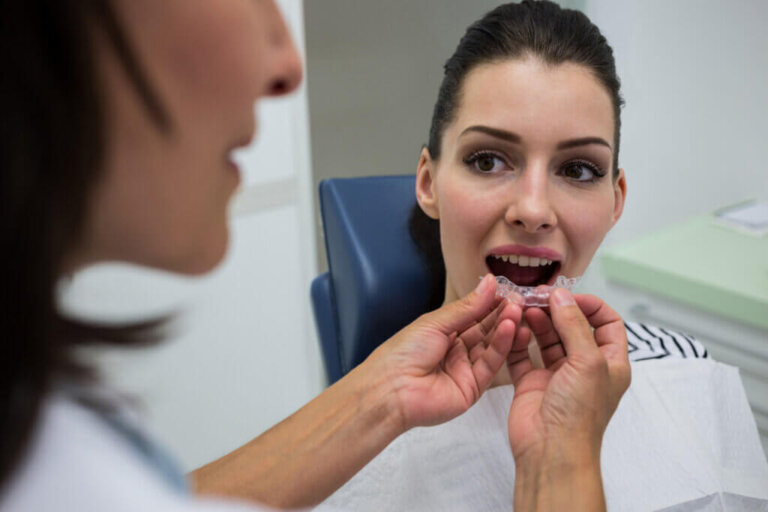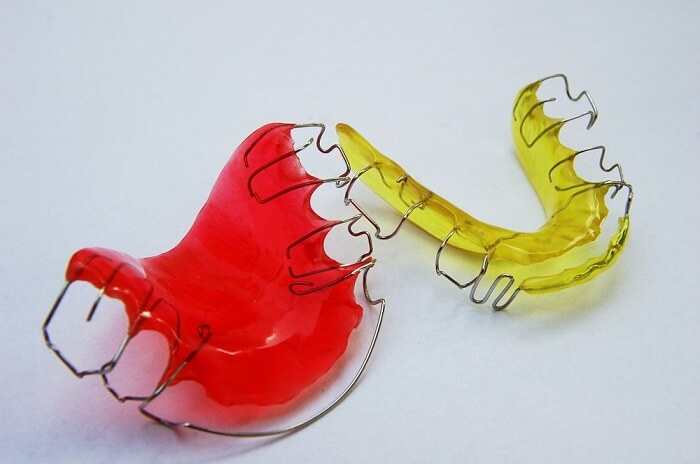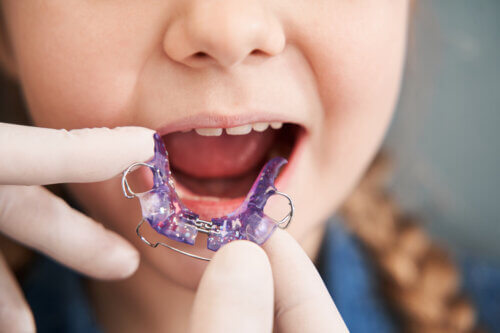Why Is It Important to Wear a Retainers After Orthodontics?


Escrito y verificado por la odontóloga Vanesa Evangelina Buffa
It’s very important to wear a retainer after orthodontics in order for the treatment to be successful. These attachments allow you to preserve the results obtained and prevent the teeth from returning to the position they had before using appliances.
Although many people think that orthodontics ends when the appliances are removed, this isn’t the case. The retention phase is part of the therapy, and it determines whether or not the results obtained are sustained over time. We’ll explain everything you need to know in the following article.
Why is it necessary to wear a retainer after orthodontics?

Dental retainers are devices that are placed in the mouth of patients when the active phase of orthodontic treatment ends. They begin to be used when the expected alignment of the bite has been achieved and the appliances have been removed.
The rationale for the use of retainers lies in the tendency of the teeth to return to their old position. These devices keep the teeth in their new location until the bite and oral tissues adapt. This way, the results of orthodontics can be sustained over time.
As a review article published in the Revista Científica Odontológica indicates, the retention phase is necessary to avoid relapse or the loss of the results obtained.
Removing the brackets and wires or stopping using the aligners can allow the teeth to return to their original position. The elasticity of the tissues and the pressure of the tongue and facial muscles can favor this regression.
If this happens, the bite will return to the same way it was before orthodontic treatment. This phenomenon is known as “recurrence” and can occur due to several factors. In any case, according to a review article published in the Metropolitan Journal of Applied Sciences, it’s more common in patients who don’t wear their retainer properly.
Retainers don’t exert any movement or force on the teeth; they simply keep them in their new location. Therefore, at this stage, the patient doesn’t experience pressure and pain.
The orthodontist is in charge of designing and indicating the use of retainers to stabilize the teeth in their new position. All patients undergoing orthodontic treatment have to go through the retention stage as part of the therapy.
An article published in the British Dental Journal clarifies that the orthodontist will use some method of retention in virtually all patients, after completing active treatment.
The importance of wearing retainers after orthodontics
We already mentioned that the main function of retainers is to prevent recurrences after orthodontic treatments. Next, we’ll detail the advantages of its use:
- Maintenance of treatment results: Once the bite has been optimized, after orthodontic treatment, retainers help maintain long-term results. These devices stabilize the teeth in their new position and prevent them from shifting.
- Tissue adaptation: After orthodontics, the tissues surrounding the teeth need time to adapt to their new position. Retainers allow tissues to gradually adjust to orofacial changes.
- Smile Care: Wearing retainers after orthodontics helps develop and sustain dental care habits. When the patient commits to the use of these attachments, they usually also take care of the hygiene of their entire mouth.
- Saving time and money: Failure to use retainers can lead to failure of orthodontic treatment. When there are recurrences, it’s important to correct the problem again with new appliances, which requires time and money.
How long should patients wear a retainer after orthodontics?
The duration of the retention phase depends on each clinical case and the time it takes for the oral tissues to adapt to their new arrangement. Literature suggests that orthodontists have a personalized approach in this stage of treatment, considering the characteristics prior to orthodontics, the changes achieved, whether the patient is in the growth stage, and other particularities.
In general, the adaptation of the tissues usually takes between 12 and 16 months. Therefore, the use of retainers lasts approximately one year, although some treatments may require patients to wear a retainer for more time.
At first, as soon as orthodontics is finished, the use of retainers is intensive: The patient must wear them most of the day. As the months go by, their use is reduced to a few hours a day; in general, only at night, while sleeping.
To prevent unwanted tooth movement, the orthodontist usually places fixed retainers the same day the brace is removed. In addition, splints are made to measure that will act as removable retainers. These times are estimates, and the final decision on the duration of the retention phase corresponds to the orthodontist.
Types of dental retainers
Retainers used after orthodontics can be fixed or removable. We’ll tell you their main characteristics and differences.
Fixed retainers
These are fine wire splints that are cemented onto the palatal or lingual surfaces of the teeth to immobilize them. In general, they extend from canine to canine, although the arrangement may change depending on the clinical case.
As they are fixed, the patient can’t remove the retention device by themself. Because they’re on the inner faces of the dental elements, they’re a very aesthetic option, as they go unnoticed by the naked eye. At first, the patient will have to get used to their presence, but with time, there’ll be no problems speaking or eating.
As they’re wires that are attached to the teeth, bacterial plaque can accumulate, which is why they require special attention to oral hygiene. In addition, rubbing with the tongue can cause traumatic lesions in the mucosa.
They’re the ideal choice when the goal is necessary to maintain an open space. For example, to later place an implant.
[/atomik-read -too]
Removable dental retainers

As the name implies, these retainers can be put on and taken off by the patient. The dentist indicates the mode and time of use. In general, patients must wear retainers throughout the day for the first few months and less frequently as the months go by.
It’s advisable to remove them to eat and clean the mouth. In addition, it’s important to keep them clean and always store them in the same place to prevent them from being damaged or lost.
In this case, the success of retention depends on the patient’s perseverance and commitment to treatment. If the person does not wear the retainers properly, the risk of unwanted tooth movement increases. According to a review that compared fixed and removable retainers, patients who used the former felt more confident that future recurrences wouldn’t occur.
There are two types of removable retainers:
- Transparent plates: These are transparent plastic splints that are placed on the teeth.
- Metal retainers: These are devices made with a metal arch attached to an acrylic plate that rests on the palate.
Retainers to sustain the results after orthodontics
Retainers play a crucial role in maintaining the results of orthodontic treatment. They allow tissues to adapt to changes and not return to their previous situation.
Complying with this stage and following the orthodontist’s recommendations is essential to prevent recurrence. Engagement during this phase allows the smile to remain aligned and stable over time.
It’s very important to wear a retainer after orthodontics in order for the treatment to be successful. These attachments allow you to preserve the results obtained and prevent the teeth from returning to the position they had before using appliances.
Although many people think that orthodontics ends when the appliances are removed, this isn’t the case. The retention phase is part of the therapy, and it determines whether or not the results obtained are sustained over time. We’ll explain everything you need to know in the following article.
Why is it necessary to wear a retainer after orthodontics?

Dental retainers are devices that are placed in the mouth of patients when the active phase of orthodontic treatment ends. They begin to be used when the expected alignment of the bite has been achieved and the appliances have been removed.
The rationale for the use of retainers lies in the tendency of the teeth to return to their old position. These devices keep the teeth in their new location until the bite and oral tissues adapt. This way, the results of orthodontics can be sustained over time.
As a review article published in the Revista Científica Odontológica indicates, the retention phase is necessary to avoid relapse or the loss of the results obtained.
Removing the brackets and wires or stopping using the aligners can allow the teeth to return to their original position. The elasticity of the tissues and the pressure of the tongue and facial muscles can favor this regression.
If this happens, the bite will return to the same way it was before orthodontic treatment. This phenomenon is known as “recurrence” and can occur due to several factors. In any case, according to a review article published in the Metropolitan Journal of Applied Sciences, it’s more common in patients who don’t wear their retainer properly.
Retainers don’t exert any movement or force on the teeth; they simply keep them in their new location. Therefore, at this stage, the patient doesn’t experience pressure and pain.
The orthodontist is in charge of designing and indicating the use of retainers to stabilize the teeth in their new position. All patients undergoing orthodontic treatment have to go through the retention stage as part of the therapy.
An article published in the British Dental Journal clarifies that the orthodontist will use some method of retention in virtually all patients, after completing active treatment.
The importance of wearing retainers after orthodontics
We already mentioned that the main function of retainers is to prevent recurrences after orthodontic treatments. Next, we’ll detail the advantages of its use:
- Maintenance of treatment results: Once the bite has been optimized, after orthodontic treatment, retainers help maintain long-term results. These devices stabilize the teeth in their new position and prevent them from shifting.
- Tissue adaptation: After orthodontics, the tissues surrounding the teeth need time to adapt to their new position. Retainers allow tissues to gradually adjust to orofacial changes.
- Smile Care: Wearing retainers after orthodontics helps develop and sustain dental care habits. When the patient commits to the use of these attachments, they usually also take care of the hygiene of their entire mouth.
- Saving time and money: Failure to use retainers can lead to failure of orthodontic treatment. When there are recurrences, it’s important to correct the problem again with new appliances, which requires time and money.
How long should patients wear a retainer after orthodontics?
The duration of the retention phase depends on each clinical case and the time it takes for the oral tissues to adapt to their new arrangement. Literature suggests that orthodontists have a personalized approach in this stage of treatment, considering the characteristics prior to orthodontics, the changes achieved, whether the patient is in the growth stage, and other particularities.
In general, the adaptation of the tissues usually takes between 12 and 16 months. Therefore, the use of retainers lasts approximately one year, although some treatments may require patients to wear a retainer for more time.
At first, as soon as orthodontics is finished, the use of retainers is intensive: The patient must wear them most of the day. As the months go by, their use is reduced to a few hours a day; in general, only at night, while sleeping.
To prevent unwanted tooth movement, the orthodontist usually places fixed retainers the same day the brace is removed. In addition, splints are made to measure that will act as removable retainers. These times are estimates, and the final decision on the duration of the retention phase corresponds to the orthodontist.
Types of dental retainers
Retainers used after orthodontics can be fixed or removable. We’ll tell you their main characteristics and differences.
Fixed retainers
These are fine wire splints that are cemented onto the palatal or lingual surfaces of the teeth to immobilize them. In general, they extend from canine to canine, although the arrangement may change depending on the clinical case.
As they are fixed, the patient can’t remove the retention device by themself. Because they’re on the inner faces of the dental elements, they’re a very aesthetic option, as they go unnoticed by the naked eye. At first, the patient will have to get used to their presence, but with time, there’ll be no problems speaking or eating.
As they’re wires that are attached to the teeth, bacterial plaque can accumulate, which is why they require special attention to oral hygiene. In addition, rubbing with the tongue can cause traumatic lesions in the mucosa.
They’re the ideal choice when the goal is necessary to maintain an open space. For example, to later place an implant.
[/atomik-read -too]
Removable dental retainers

As the name implies, these retainers can be put on and taken off by the patient. The dentist indicates the mode and time of use. In general, patients must wear retainers throughout the day for the first few months and less frequently as the months go by.
It’s advisable to remove them to eat and clean the mouth. In addition, it’s important to keep them clean and always store them in the same place to prevent them from being damaged or lost.
In this case, the success of retention depends on the patient’s perseverance and commitment to treatment. If the person does not wear the retainers properly, the risk of unwanted tooth movement increases. According to a review that compared fixed and removable retainers, patients who used the former felt more confident that future recurrences wouldn’t occur.
There are two types of removable retainers:
- Transparent plates: These are transparent plastic splints that are placed on the teeth.
- Metal retainers: These are devices made with a metal arch attached to an acrylic plate that rests on the palate.
Retainers to sustain the results after orthodontics
Retainers play a crucial role in maintaining the results of orthodontic treatment. They allow tissues to adapt to changes and not return to their previous situation.
Complying with this stage and following the orthodontist’s recommendations is essential to prevent recurrence. Engagement during this phase allows the smile to remain aligned and stable over time.
- Al-Moghrabi, D., Littlewood, S. J., & Fleming, P. S. (2021). Orthodontic retention protocols: An evidence-based overview. British Dental Journal, 230(11), 770-776. https://www.nature.com/articles/s41415-021-2954-7
- Chacón-Moreno, A., Ramírez-Mejía, M. J., & Zorrilla-Mattos, A. C. (2022). Recidiva y movimiento dental involuntario después del tratamiento de ortodoncia en personas con retenedores fijos: Una revisión. Revista Científica Odontológica, 10(3), e116-e116. https://revistas.cientifica.edu.pe/index.php/odontologica/article/view/1331
- del Carmen Zhinín-González, M., & Pulgarin-Fernández, C. M. (2023). Uso de retención en ortodoncia,¿ es necesario? Revisión de literatura. Revista Metropolitana de Ciencias Aplicadas, 6(S1), 234-241. http://remca.umet.edu.ec/index.php/REMCA/article/view/649
- Fudalej, P. S., & Renkema, A. M. (2021). A brief history of orthodontic retention. British Dental Journal, 230(11), 777-780. https://www.nature.com/articles/s41415-021-2955-6
- Gómez, M., Herrera Luz, E., Suárez, Á., & Sánchez, G. (2017). Efectividad de la retención post ortodoncia en pacientes de 12-35 años relacionada con 2 tipos de retención fija. Revisión sistemática de la literatura. Odontoestomatología, 19(29), 18-32. http://www.scielo.edu.uy/scielo.php?pid=S1688-93392017000100018&script=sci_arttext
- Jaimes-Monroy, G., Jiménez, M. T., Manga, E. A., Montero-Hincapié, L. A., Portela, E. J., & Longlax-Triana, M. C. (2020). Mechanical and non-mechanical orthodontic procedures in relapse and retention: scoping review. Revista Facultad de Odontología Universidad de Antioquia, 32(2), 82-96. https://revistas.udea.edu.co/index.php/odont/article/view/342425
- Zurita, C. F. Y., Freire, B. V. N., Fabiola, J., & Reinoso, A. (2022). Retenedores postratamiento de Ortodoncia: fijos vs. removibles. Revisión de la Literatura Orthodontic post-treatment retainers: fixed vs. removable. Literature Review. Revista Multidisciplinaria de Posgrado. Vol, 2(2). https://www.researchgate.net/profile/Christian-Yanez-Zurita/publication/369649950_Retenedores_postratamiento_de_Ortodoncia_fijos_vs_removibles_Revision_de_la_Literatura_Orthodontic_post-treatment_retainers_fixed_vs_removable_Literature_Review/links/6425e4df66f8522c38e447be/Retenedores-postratamiento-de-Ortodoncia-fijos-vs-removibles-Revision-de-la-Literatura-Orthodontic-post-treatment-retainers-fixed-vs-removable-Literature-Review.pdf
Este texto se ofrece únicamente con propósitos informativos y no reemplaza la consulta con un profesional. Ante dudas, consulta a tu especialista.







